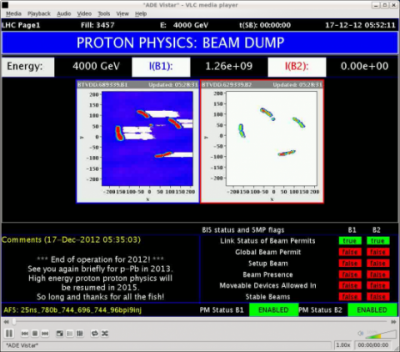Dec 18 2012
This morning CERN completed the first LHC proton run. The remarkable first three-year run of the world’s most powerful particle accelerator was crowned by a new performance milestone.
 The final beam of the three-year proton run at the LHC is dumped, with the phrase "So long and thanks for all the fish" from the control team (Image: CERN)
The final beam of the three-year proton run at the LHC is dumped, with the phrase "So long and thanks for all the fish" from the control team (Image: CERN)
The space between proton bunches in the beams was halved to further increase beam intensity.
“This new achievement augurs well for the next LHC run starting in 2015,” said CERN’s Director for Accelerators and Technology, Steve Myers, “High intensity beams are vital for the success of the LHC programme. More intense beams mean more collisions and a better chance of observing rare phenomena.”
To put this into context, of the 6 million billion proton-proton collisions generated by the LHC, the ATLAS and CMS experiments have each recorded around 5 billion collisions of interest over the last three years. Of these, only around 400 produced results compatible with the Higgs-like particle whose discovery was announced in July.
A beam in the LHC is not a continuous string of particles, but is divided into hundreds of bunches, each a few tens of centimetres long. Each bunch contains more than a hundred billion protons. During the last few days, the space between bunches has been successfully halved, achieving the design specification of 25 nanoseconds rather than the 50 nanoseconds used so far. Halving the bunch spacing allows the number of bunches in the beam to be doubled. A record number of 2748 bunches was recorded in each beam last weekend, almost twice as many as the maximum reached previously in 2012, but at the injection energy of 450 GeV and without collisions. Several hours of physics were then performed with up to 396 bunches in each beam, spaced by 25 nanoseconds, each beam being accelerated to the energy of 4 TeV.
“The LHC’s performance has exceeded all expectations over the last three years,” said Steve Myers, “The accelerator delivered more than 6 million billion collisions and the luminosity has continuously increased. It’s a fantastic achievement, and I’m incredibly proud of my team.”
The luminosity, a crucial parameter measuring the rate of collisions of an accelerator, has reached a value of 7.7x1033cm-2s-1, more than twice the maximum value obtained in 2011 (3.5x1033cm-2s-1). The collision energy was increased from 7 TeV in 2011 to 8 TeV in 2012.
This year-on-year improvement in performance has allowed the LHC experiments to obtain important results quicker than expected. In addition to the spectacular discovery of a Higgs-like particle announced in July, the experiments have led to many other studies improving our understanding of fundamental matter.
At the beginning of 2013, the LHC will collide protons with lead ions before going into a long maintenance stop until the end of 2014. Running will resume in 2015 with increased collision energy of 13 TeV and another increase in luminosity.